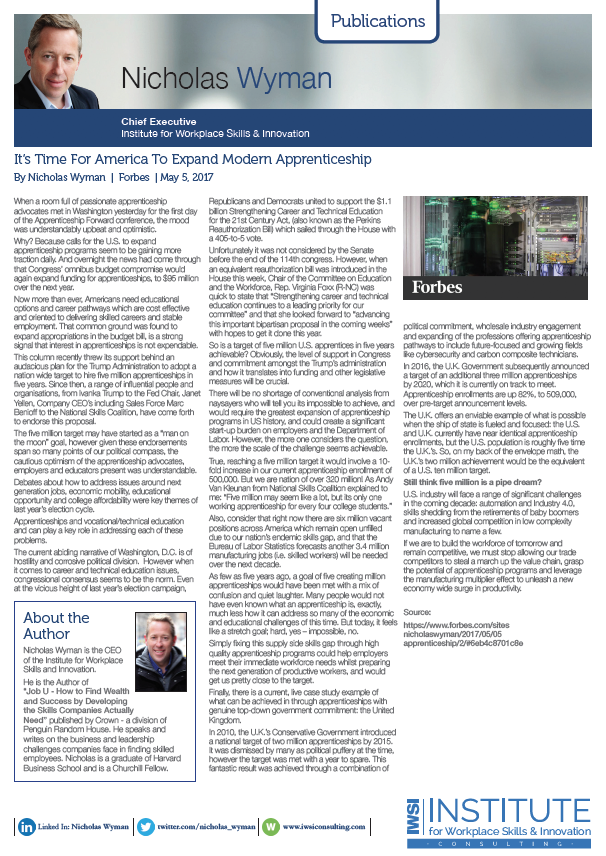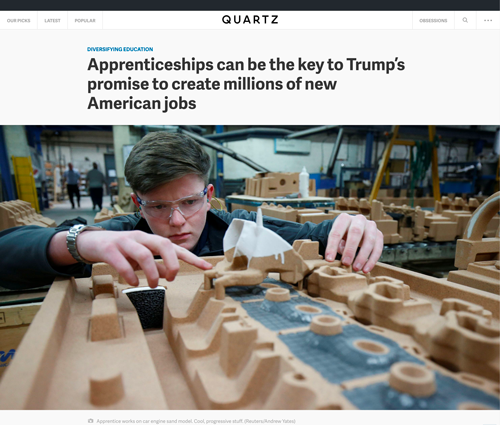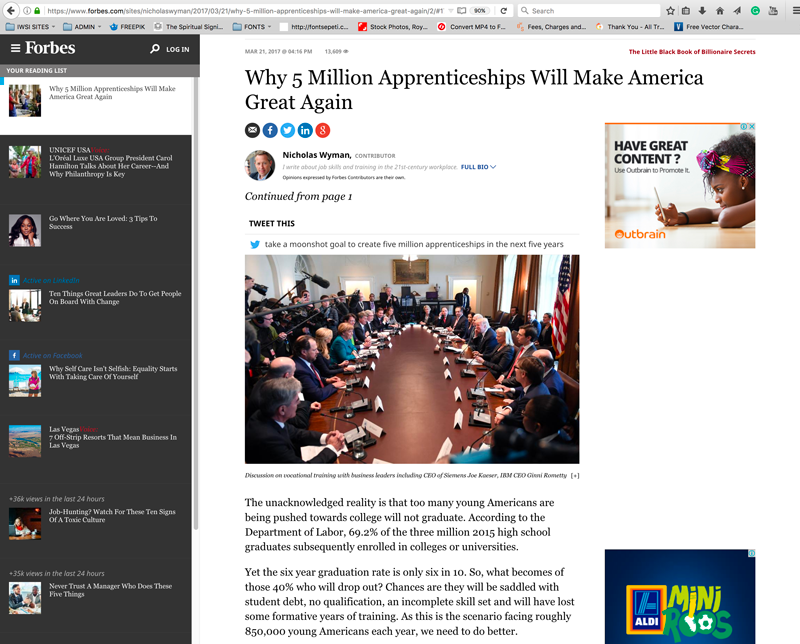
By Nicholas Wyman, May 5, 2017
When a room full of passionate apprenticeship advocates met in Washington yesterday for the first day of the Apprenticeship Forward conference, the mood was understandably upbeat and optimistic.
Why? Because calls for the U.S. to expand apprenticeship programs seem to be gaining more traction daily. And overnight the news had come through that Congress’ omnibus budget compromise would again expand funding for apprenticeships, to $95 million over the next year.
Now more than ever, Americans need educational options and career pathways which are cost effective and oriented to delivering skilled careers and stable employment. That common ground was found to expand appropriations in the budget bill, is a strong signal that interest in apprenticeships is not expendable.
This column recently threw its support behind an audacious plan for the Trump Administration to adopt a nation wide target to hire five million apprenticeships in five years. Since then, a range of influential people and organisations, from Ivanka Trump to the Fed Chair, Janet Yellen, Company CEO’s including Sales Force Marc Benioff to the National Skills Coalition, have come forth to endorse this proposal.
The five million target may have started as a “man on the moon” goal, however given these endorsements span so many points of our political compass, the cautious optimism of the apprenticeship advocates, employers and educators present was understandable.
Debates about how to address issues around next generation jobs, economic mobility, educational opportunity and college affordability were key themes of last year’s election cycle.
Apprenticeships and vocational/technical education and can play a key role in addressing each of these problems.
The current abiding narrative of Washington, D.C. is of hostility and corrosive political division. However when it comes to career and technical education issues, congressional consensus seems to be the norm. Even at the vicious height of last year’s election campaign, Republicans and Democrats united to support the $1.1 billion Strengthening Career and Technical Education for the 21st Century Act, (also known as the Perkins Reauthorization Bill) which sailed through the House with a 405-to-5 vote.
Unfortunately it was not considered by the Senate before the end of the 114th congress. However, when an equivalent reauthorization bill was introduced in the House this week, Chair of the Committee on Education and the Workforce, Rep. Virginia Foxx (R-NC) was quick to state that “Strengthening career and technical education continues to a leading priority for our committee” and that she looked forward to “advancing this important bipartisan proposal in the coming weeks” with hopes to get it done this year.
So is a target of five million U.S. apprentices in five years achievable? Obviously, the level of support in Congress and commitment amongst the Trump’s administration and how it translates into funding and other legislative measures will be crucial.

There will be no shortage of conventional analysis from naysayers who will tell you its impossible to achieve, and would require the greatest expansion of apprenticeship programs in US history, and could create a significant start-up burden on employers and the Department of Labor. However, the more one considers the question, the more the scale of the challenge seems achievable.
True, reaching a five million target it would involve a 10-fold increase in our current apprenticeship enrollment of 500,000. But we are nation of over 320 million! As Andy Van Kleunan from National Skills Coalition explained to me: “Five million may seem like a lot, but its only one working apprenticeship for every four college students.”
Also, consider that right now there are six million vacant positions across America which remain open unfilled due to our nation’s endemic skills gap, and that the Bureau of Labor Statistics forecasts another 3.4 million manufacturing jobs (i.e. skilled workers) will be needed over the next decade.
As few as five years ago, a goal of five creating million apprenticeships would have been met with a mix of confusion and quiet laughter. Many people would not have even known what an apprenticeship is, exactly, much less how it can address so many of the economic and educational challenges of this time. But today, it feels like a stretch goal; hard, yes – impossible, no.
Simply fixing this supply side skills gap through high quality apprenticeship programs could help employers meet their immediate workforce needs whilst preparing the next generation of productive workers, and would get us pretty close to the target.
Finally, there is a current, live case study example of what can be achieved in through apprenticeships with genuine top-down government commitment: the United Kingdom.
In 2010, the U.K.’s Conservative Government introduced a national target of two million apprenticeships by 2015. It was dismissed by many as political puffery at the time, however the target was met with a year to spare. This fantastic result was achieved through a combination of political commitment, wholesale industry engagement and expanding of the professions offering apprenticeship pathways to include future-focused and growing fields like cybersecurity and carbon composite technicians.
In 2016, the U.K. Government subsequently announced a target of an additional three million apprenticeships by 2020, which it is currently on track to meet. Apprenticeship enrollments are up 82%, to 509,000, over pre-target announcement levels.
The U.K. offers an enviable example of what is possible when the ship of state is fueled and focused: the U.S. and U.K. currently have near identical apprenticeship enrollments, but the U.S. population is roughly five time the U.K.’s. So, on my back of the envelope math, the U.K.’s two million achievement would be the equivalent of a U.S. ten million target.
Still think five million is a pipe dream?
U.S. industry will face a range of significant challenges in the coming decade: automation and Industry 4.0, skills shedding from the retirements of baby boomers and increased global competition in low complexity manufacturing to name a few.
If we are to build the workforce of tomorrow and remain competitive, we must stop allowing our trade competitors to steal a march up the value chain, grasp the potential of apprenticeship programs and leverage the manufacturing multiplier effect to unleash a new economy wide surge in productivity.
Source:
https://www.forbes.com/sites/nicholaswyman/2017/05/05/apprenticeship/2/#6eb4c8701c8e






